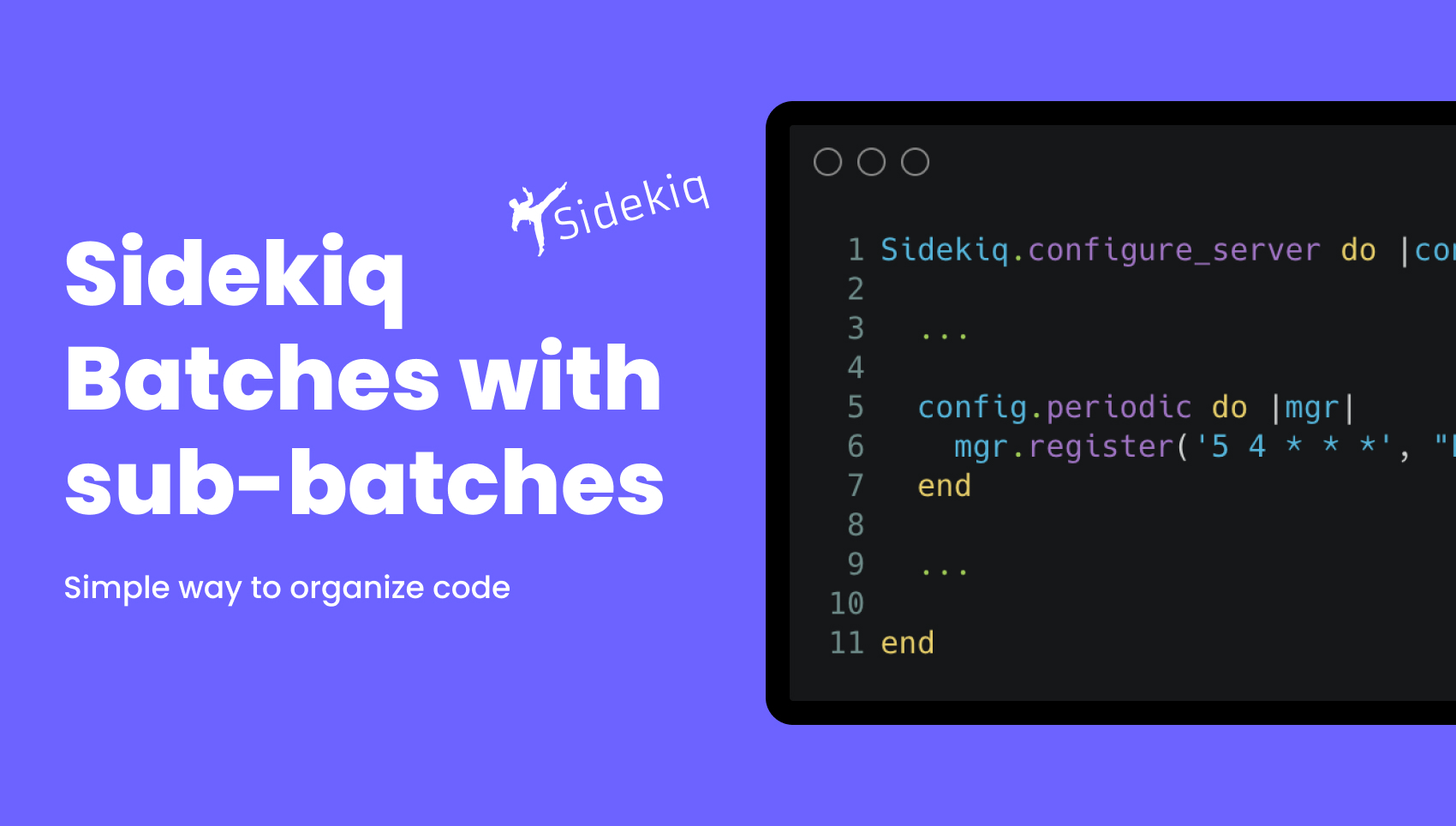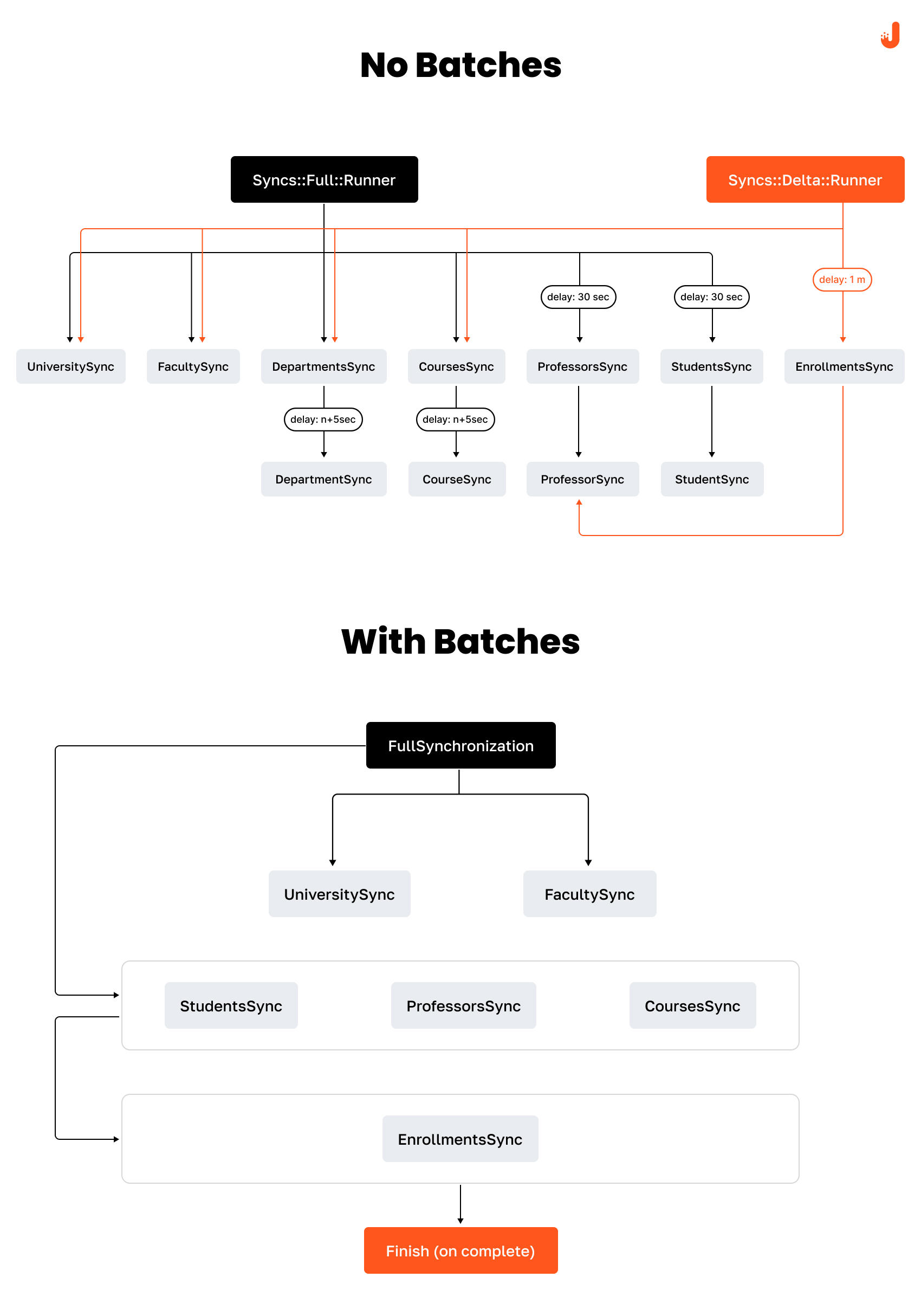Table of Contents
Sidekiq Batches is a powerful feature in the Sidekiq job processing framework that allows you to process jobs in groups. This means you can bundle a set of jobs together and execute them as a single unit, managing dependencies and making batch processing more efficient. In this article, I’ll share our journey of using this tool in a real project and how we developed a wrapper to optimize performance and reliability.
The Challenge
We had a project that required seamless synchronization between multiple systems. This is a common scenario where you need to sync a list of resources across different services, and naturally, we turned to Sidekiq for handling this background process.
Our process was straightforward:
- Retrieve a list of resources.
- Initiate synchronization for each resource.
This could also be done individually if only one resource needed synchronization.
Our Resources Included:
UniversitySync #University class
FacultySync #Faculties class
DepartmentsSync → DepartmentSync #Departments
CoursesSync → CourseSync #Courses
ProfessorsSync → ProfessorSync #Professors
StudentsSync → StudentSync #Students
EnrollmentsSync → EnrollmentSync #EnrollmentsWhile these granular classes made it easy to scale the synchronization process across various resource types, we couldn’t synchronize all resources in parallel due to dependencies. For instance, Students needed to be synchronized before Enrollments, and both University and Faculties needed synchronization before any other resources.
Addressing Synchronization Challenges with Vanilla Sidekiq
Initially, we tried introducing delays between synchronizations. However, this method came with significant challenges:
- Unpredictability: Managing and maintaining delays was difficult, leading to potential inconsistencies when dependent resources synchronized before their parent resources.
- Inefficiency: Fixed delays often cause resources to wait idly, wasting processing time and resources.
- Unclear Completion: Defining the overall synchronization process’s completion point was challenging.
Leveraging Sidekiq Batches
When we discovered the Batches mechanism of the Sidekiq Pro and Enterprise versions, it seemed like a perfect fit for managing our dependencies. By combining work in a batch with sub-batches, we hoped to close the gaps described earlier.
Cons of Sidekiq Batches Code Organization
Despite its benefits, the default code organization in Sidekiq Batches had its downsides:
- Callbacks in One Class: While this theoretically simplified things, in practice, having a massive list of batches and sub-batches in one class created a mess. Separate steps in each class would have been better for testing.
- API Handling: Developers had to manage the batches’ API, initializing the parent batch and correctly wrapping sub-batches.
It looks like this:
def step2_done(status, options)
oid = options['oid']
overall = Sidekiq::Batch.new(status.parent_bid)
overall.jobs do
step3 = Sidekiq::Batch.new # <- Sub-batch
step3.on(:success, 'FulfillmentCallbacks#step3_done', 'oid' => oid)
step3.jobs do
G.perform_async(oid)
end
end
endImplementing a Simple Wrapper
To tackle these cons, our engineers developed a wrapper solution. This wrapper allows defining batches and sub-batches in one class, with callbacks close to the batch class, simplifying the process and enhancing performance and reliability.
Wrapper Requirements:
- Define batches and sub-batches in one class.
- Have callbacks for the batch near the batch class.
Here’s a basic example of the wrapper:
# @example basic batch with callback:
#
# module DoSomeWork
# class Batch
# def enqueue
# current_batch.description = "Doing some work"
# current_batch.on(:complete, Callback)
#
# jobs do
# SomeWorker.perform_async
# SomeWorker.perform_async
# end
# end
#
# class Callback
# def on_complete(status, options)
# logger.info "Success"
# end
# end
# end
# end
#
# Usage -> DoSomeWork::Batch.enqueue
module Batches
class Base
include Testing if Rails.env.test?
attr_reader :parent_batch, :current_batch
def initialize(parent_bid = nil)
@parent_batch = if parent_bid.present?
::Sidekiq::Batch.new(parent_bid)
else
NullBatch.new
end
@current_batch = ::Sidekiq::Batch.new
end
delegate :description=, :description, :bid, to: :current_batch
# @note Simple batch initialization when you don't want to define callbacks.
# @param [String] sync_run_id
# @param [String] parent_bid - should be passed if it's a sub-batch
# @return [Batches::Base]
def self.enqueue(sync_run_id:, parent_bid: nil)
batch = new(parent_bid)
batch.enqueue(sync_run_id)
batch
end
def enqueue(sync_run_id)
raise NotImplementedError
end
def on(*args)
current_batch.on(*args)
self
end
private
def jobs(&block)
parent_batch.jobs { current_batch.jobs(&block) }
end
end
endUsing the Wrapper for Batches and Sub-batches
module UniversityAndFaculty
class Batch < ::Base
def enqueue(run_id)
current_batch.description = "University/Faculty sync for #{run_id}"
current_batch.on(:complete, Callback, run_id: run_id)
jobs do
::Syncs::UniversitySyncWorker.perform_async(run_id)
::Syncs::FacultySyncWorker.perform_async(run_id)
end
end
end
class Callback
def on_complete(status, options)
# enqueue sub-batch
DepartmentsAndCourses::Batch.enqueue(
run_id: options['run_id'],
parent_bid: status.parent_bid
)
end
end
endWith this wrapper, our batches and sub-batch classes looked almost identical because the complexity of the Sidekiq Batch API was hidden in the Base class. This organization made our code cleaner, faster, and more reliable.
Summing up
Our journey to streamline the synchronization process led us to Sidekiq’s Batches feature, which provided a solid foundation but also came with its own set of challenges. Instead of letting these issues slow us down, our engineering team developed a wrapper that simplified batch and sub-batch definitions, making the code easier to manage and more reliable.
We hope our experience and solution inspire other Ruby developers facing similar issues. Our wrapper isn’t just a tool; it’s a testament to our commitment to writing efficient, effective code. Stay tuned to our blog for more stories and solutions from our engineering team.




